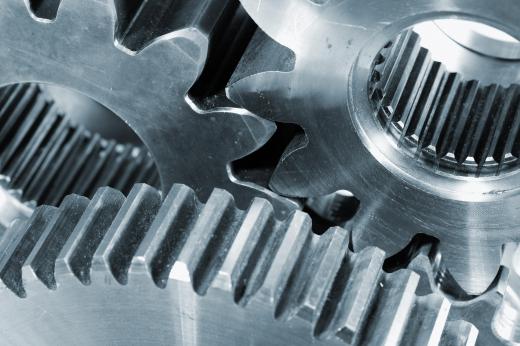At AboutMechanics, we're committed to delivering accurate, trustworthy information. Our expert-authored content is rigorously fact-checked and sourced from credible authorities. Discover how we uphold the highest standards in providing you with reliable knowledge.
What is a Spur Gear?
A spur gear is the simplest and most common type of gear. It is essentially a disk with a series of uniform teeth projecting along the outer edge. The spur gear is used in many everyday devices, from the tiny plastic ones in wind-up toys to the large metal versions used in industrial washing machines.
The purpose of any gear is to translate the speed of a motor into the rotational force, or torque, needed to make a device work. The process of translating speed to torque is known as gear reduction because the speed of the motor is inputted to the gears and then reduced before being outputted to the rotational device. The rotational force of a series of gears is usually written as a ratio.

At least two gears must work together to achieve gear reduction. A small gear and a larger gear are set up side by side with their teeth meshing. A spur gear must always be set up on a shaft that is parallel to the shaft of its companion spur gear in order for the teeth to mesh properly. Other types of gears, such as helical and bevel gears, can operate at different angles.
The shaft attached to the smaller gear is rotated by a motor, which turns the gear. As the teeth of the small gear are interlocked with the teeth of the larger spur gear, the first gear cannot turn without also turning its companion. The important point here is that, because the first gear is smaller than the second gear, it must turn more than once to make the second gear to complete a full rotation. Thus, the speed of the motor becomes rotational force. A series of several gears can be used to increase gear reduction even more.
Spur gears have an advantage over other kinds of gears because they have a simple design and are inexpensive to manufacture. They can be made out of any hard material from plastic to steel, but they have several drawbacks when it comes to functionality. When two spur gears rotate together, they tend to make a lot of noise. This is because the teeth strike each other quickly. At high speeds, spur gears make a whining noise that makes them unsuitable for use in devices for which noise is a consideration. The other drawback of spur gears is that they must be set up on parallel shafts, which creates certain design restrictions.
AS FEATURED ON:
AS FEATURED ON:











Discuss this Article
Post your comments